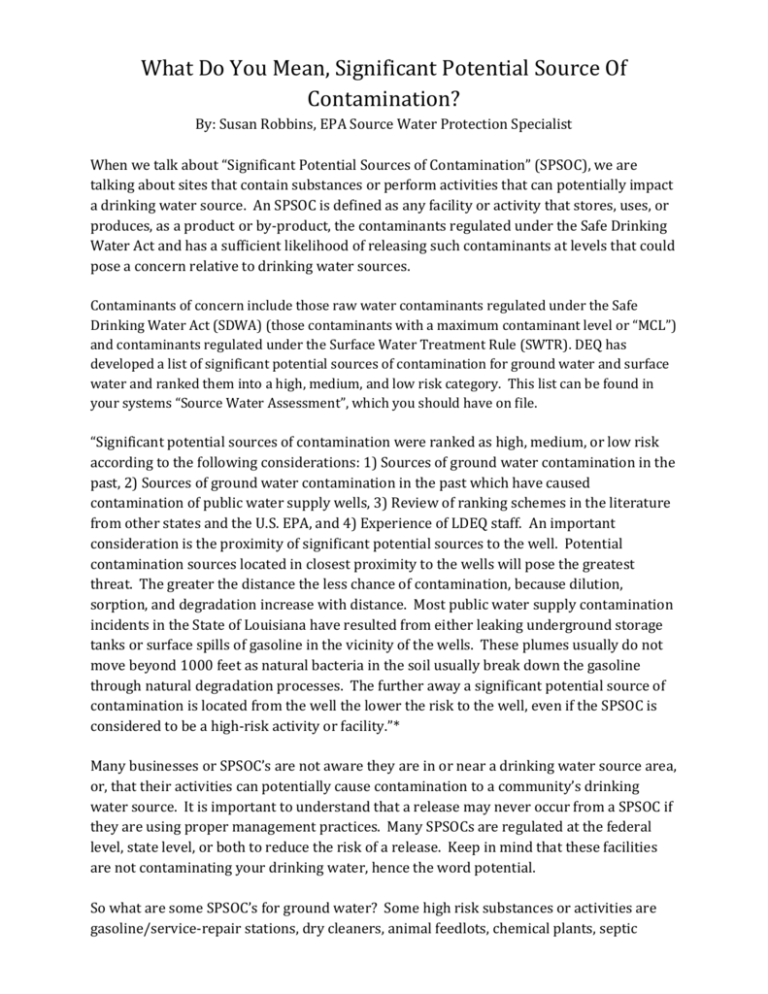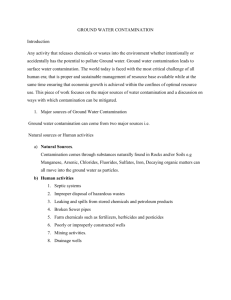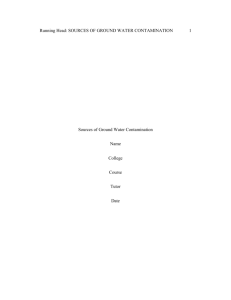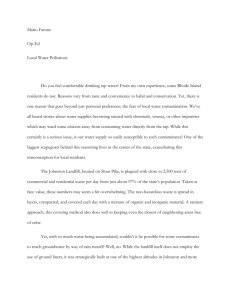What Do You Mean, Significant Potential Source Of Contamination
advertisement

What Do You Mean, Significant Potential Source Of Contamination? By: Susan Robbins, EPA Source Water Protection Specialist When we talk about “Significant Potential Sources of Contamination” (SPSOC), we are talking about sites that contain substances or perform activities that can potentially impact a drinking water source. An SPSOC is defined as any facility or activity that stores, uses, or produces, as a product or by-product, the contaminants regulated under the Safe Drinking Water Act and has a sufficient likelihood of releasing such contaminants at levels that could pose a concern relative to drinking water sources. Contaminants of concern include those raw water contaminants regulated under the Safe Drinking Water Act (SDWA) (those contaminants with a maximum contaminant level or “MCL”) and contaminants regulated under the Surface Water Treatment Rule (SWTR). DEQ has developed a list of significant potential sources of contamination for ground water and surface water and ranked them into a high, medium, and low risk category. This list can be found in your systems “Source Water Assessment”, which you should have on file. “Significant potential sources of contamination were ranked as high, medium, or low risk according to the following considerations: 1) Sources of ground water contamination in the past, 2) Sources of ground water contamination in the past which have caused contamination of public water supply wells, 3) Review of ranking schemes in the literature from other states and the U.S. EPA, and 4) Experience of LDEQ staff. An important consideration is the proximity of significant potential sources to the well. Potential contamination sources located in closest proximity to the wells will pose the greatest threat. The greater the distance the less chance of contamination, because dilution, sorption, and degradation increase with distance. Most public water supply contamination incidents in the State of Louisiana have resulted from either leaking underground storage tanks or surface spills of gasoline in the vicinity of the wells. These plumes usually do not move beyond 1000 feet as natural bacteria in the soil usually break down the gasoline through natural degradation processes. The further away a significant potential source of contamination is located from the well the lower the risk to the well, even if the SPSOC is considered to be a high-risk activity or facility.”* Many businesses or SPSOC’s are not aware they are in or near a drinking water source area, or, that their activities can potentially cause contamination to a community’s drinking water source. It is important to understand that a release may never occur from a SPSOC if they are using proper management practices. Many SPSOCs are regulated at the federal level, state level, or both to reduce the risk of a release. Keep in mind that these facilities are not contaminating your drinking water, hence the word potential. So what are some SPSOC’s for ground water? Some high risk substances or activities are gasoline/service-repair stations, dry cleaners, animal feedlots, chemical plants, septic systems, abandon wells. Medium risks include injection wells, oxidation ponds, sanitary landfills, sewer treatment plants, oil & gas well drilling activities. Low risks include car washes, cemeteries, and golf courses. If you need help identifying SPSOC’s around you drinking water sources, give us a call. LRWA has two, Source Water Protection Specialist to assist you. *Source: Louisiana Source Water Assessment Program Plan, revised April 2001 *Original article published in LRWA magazine – Spring 2011 SPSOCs of Concern Affecting Groundwater A significant potential source of contamination (SPSOC) is defined as any facility or activity that stores, uses, or produces, as a product or by-product, the contaminants regulated under the Safe Drinking Water Act and has a sufficient likelihood of releasing such contaminants at levels that could pose a concern relative to drinking water sources. The SPSOC locations were obtained by field surveys and from available databases. The list of significant potential sources and their rankings used to develop the assessment is shown below. Higher Risk Agriculture Chemical Formulation Animal Feed Lots (CAFO) Battery Shop/Recyclers Body/Paint Shop Dry Cleaners Inactive/Abandoned Site – Confirmed Injection Well (Class V) Major Industrial Site Plume Military Facility Petrochemical Plant Petroleum Bulk Plant Remediation Site – Groundwater Remediation Site – Hazardous Waste Remediation Site – Solid Waste Remediation Site - UST Storage Tank – Above Ground (w/o secondary containment) Storage Tank – Underground (Active) Storage Tank – Underground (Inactive) Truck terminal Water Well – Abandoned Water Well - Inactive Wood Preserving/Treatment Plant Medium Risk Airport/Airstrip Auto/Boat/Tractor/Small Engine Shop Furniture Stripping Inactive & Abandoned Site – Potential Injection Well (Class I, II, or III) Oil/Gas Tank Battery Promiscuous Dump Railroad Yard –(Loading/Switching/Maintenance) Sand/Gravel Pit Landfill (Solid Waste/Municipal/C&D) Sewerage – Oxidation Pond Sewerage – Treatment Plant Storage Tank – Above Ground (w/Secondary Containment) Low Risk Asphalt Plant Car Wash Cemetery Funeral Home Golf Course Hospital Lumber Mill Metal Plating/Metal Working Paper Mill Pipeline Compressor Stations Plant Nursery Port Facilities Power Plant – Not Nuclear Power Plant - Nuclear Print Shop Salvage Yard Sewer – Lift Station Water Well - Irrigation Line Potential Sources of Contamination: Line feature Potential Sources of Contamination (LPSOCs), such as Roads, Railroads, and Pipelines, are subject to spills and leaks. LPSOCs will be rated based on a pertinent number per square mile in the delineated area (protection area). Oil & Gas Wells and Septic Tanks: Active oil & gas wells (as determined from LDNR’s SONRIS database) will be rated based on a pertinent number per square mile in the delineated area. Septic tanks will be rated based on the number of septic tanks within the septic tank search radius. This radius is determined by applying the distance ground water would travel in two years based on the aquifer’s average ground water velocity per year (two year time of travel). It is important to note the contaminants of concern listed for each SPSOC are not intended to be comprehensive, but rather those most commonly associated with the SPSOC. In addition, any specific SPSOC may actually have none, some, or more types of contaminants associated with it than what is listed. Surface Water - Significant Potential Sources of Contamination of Concern (To Be Ground Truthed) Higher Risk Above Ground Storage Tank Agriculture ChemicalFormulation/Distribution (pesticide/insecticide) Animal Feed Lots/Dairies (Concentrated Animal Feeding Operations - CAFOs Battery Recyclers Body Shop/Paint Shop Bridges and Bridge Abutments Chemical/Industrial Plant Dry Cleaner/Laundromat Confirmed Remediation Site Military Facility Oil/Gas Tank Battery Petroleum (includes bulk plants) TRI Site (Toxic Release Inventory) Truck terminal Underground Storage Tank Wood Preserving Plant Medium Risk Airport/Airstrip Auto/Boat/Tractor/Small Engine Shop Furniture Stripping Mine Plant Nursery Promiscuous Dump Railroad Yard - Switching Railroad Yard- Loading and Offloading Railroad Yard- Maintenance RCRA Facility (Resource Conservation & Recovery Act) Sewer Treatment Plant Lower Risk Asphalt Plant Car Wash Cemetery Funeral Home Golf Course Hospital Irrigation Well (all classes) Lumber Mill Marina Metal Plating/Metal Working Nuclear Plant Oxidation Pond Paper Mill Pipeline Compressor Station Port Facilities Power Plant Printing Shops Salvage Yard Sand and Gravel Pit Sanitary landfill/Solid Waste Disposal (active or inactive) Sewer Lift Station Ship Building Operations Tailing Pond *Septic systems will be counted within the critical area and will be reported as a density. Surface Water - Significant Potential Sources of Contamination of Concern (To Be Identified By Databases) Higher Risk Louisiana Permitted Discharge Elimination System Concentrated Animal Feeding Operations (CAFOs) Military Facilities Confirmed Remediation Site TRI Sites (Toxic Release Inventory) Medium Risk Airports Airstrips Mines RCRA Sites (Resource Conservation & Recovery Act) Lower Risk Cemeteries Hospitals Injection Wells (all classes) Sand & Gravel Pits Sewage Disposal Ponds (Oxidation Ponds) Solid Waste Disposal Facilities (Landfills) Tailing Ponds Line Potential Sources of Contamination: Railroads, Pipelines, Roads, and Hazardous Waste Transportation Routes are Line Potential Sources of Contamination subject to spills and leaks. They will be rated based on a pertinent number per square mile in the delineated area. Oil & Gas Wells: Oil & Gas Wells will be reported as the number of wells per square mile in BOTH the critical and non-critical areas. *Other important but not quantifiable considerations at this time include natural occurrences, saltwater intrusion, silviculture, and recreational use. 6








